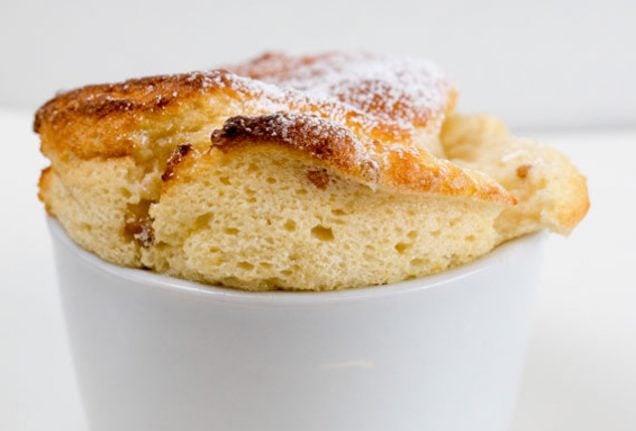Soufflés are such wonderfully theatrical desserts that they are a splendid way of finishing any meal. Using cloudberries makes it feel so Swedish and gives the soufflés an exquisite taste.
Cloudberries (hjortron) only grow in the wild in northern Scandinavia and are a much sought-after delicacy. It is possible to buy cloudberry jam (usually sold as hjortronsylt), which is used in this recipe, outside of Sweden in specialist shops or online.
Summary
Makes: 6 soufflés
Preparation: 15 minutes
Cooking: 15 minutes
Ingredients
25g (1oz) unsalted (sweet) butter, plus extra for greasing
2 tbsp caster (superfine) sugar
2 tbsp plain (all-purpose) flour
240ml (1 cup) milk
2 egg yolks
3 egg whites
140g (1 cup) cloudberry jam (hjortronsylt)
1 tbsp Lakka (Finnish cloudberry liqueur), optional
Icing (confectioner's) sugar, for dusting
Method
1. Preheat the oven to 250C (475F, gas 9, fan 200C).
2. Generously grease the insides of six individual ramekins. Coat the insides with half the sugar. This helps the soufflés rise because it gives the mixture a textured surface to climb.
3. Place a teaspoon of cloudberry jam in the bottom of each ramekin.
4. Melt the butter in a pan, add the flour and cook over a low heat for 30 seconds, stirring to make a roux. Slowly add the milk and stir continuously to form a smooth sauce. Cook until the sauce boils and thickens.
5. Remove the sauce from the heat, leave to cool slightly, then stir in the egg yolks. Add the remaining cloudberry jam and cloudberry liqueur and set aside.
6. Whisk the egg whites to form firm peaks. Fold in the remaining sugar, then the cloudberry mixture.
7. Spoon the mixture into the ramekins, smoothing the tops if you like the soufflés to rise straight, but leaving it if you like a more rustic looking top.
8. Cook for 10-12 minutes, until well risen and golden on top, but still with a slight wobble. Dust lightly with icing (confectioner's) sugar and run with them to the table before they start to sink!
Note
Whilst cold soufflés look pretty ugly they really taste every bit as good as their hot cousins, possibly even better, so if you have any soufflés left over don't throw them away.
Tips
– You can prepare the soufflé mixture up to three hours ahead, up to stage five. Store the sauce and unwhisked egg whites in sealed containers in the fridge, but for best results bring back to room temperature before continuing.
– Make sure the oven is really hot before you put the soufflés in, as they need an instant blast of heat to push up the egg whites, before they have the chance to set.
Recipe courtesy of John Duxbury, founder and editor of Swedish Food.



 Please whitelist us to continue reading.
Please whitelist us to continue reading.